Category: General
Posted by: The Agnew Family
I shouldnít have complained about the other early mornings. Today we
were up at 3am, suitcases in the lobby by 3:45am, a quick coffee, a boat
ride to the mainland at 4am then transfer to our bus for the almost 4
hour drive to Abu Simbel temple. Part of the reason for leaving so early
was to get near the front of the line at the check point so you could
get going quicker when the road opened at 5am. We donít know why the
highway closes but it may have something to do with the border with
Sudan.
A quick history on Abu Simbel. The Great Temple of Ramses II and the Temple of Hathor combine to make up the Temples Abu Simbel. The temples were carved out of the mountain on the west bank of the Nile between 1274 and 1244 BC under the direction of Ramses II. The main temple is dedicated to the deified Ramses II himself as to Ra-Horakhty, Amun and Ptah (gods). The lesser temple is in honour of Ramses IIís favourite wife (Nefertari). Over the centuries both the Nile and the desert sands shifted and the temple was lost to the world until 1813 when it was rediscovered by chance by a Swiss explorer. In the 1960ís the ruler of Egypt decided that it was necessary to build a dam on the Nile River. The resulting lake would flood this temple and it would be lost possibly forever. Unesco stepped in and sponsored a team of archeologists to move the temple. A four year project saw the temple cut into pieces of no more than 30 tons/piece, moved to a storage location, then returned to itís new home on high ground above itís original location. The original temple is amazing, the fact that it was moved is amazing and the fact that you canít tell it was moved is even more amazing.
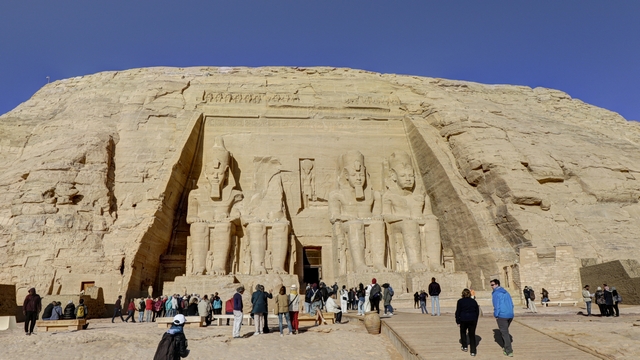
The front of the main temple

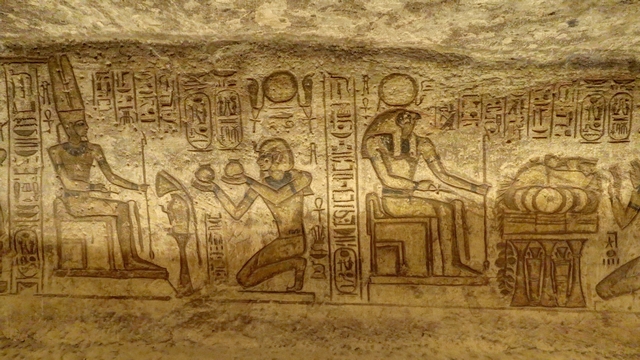
The inside of the main temple was filled with statues and amazing carvings.
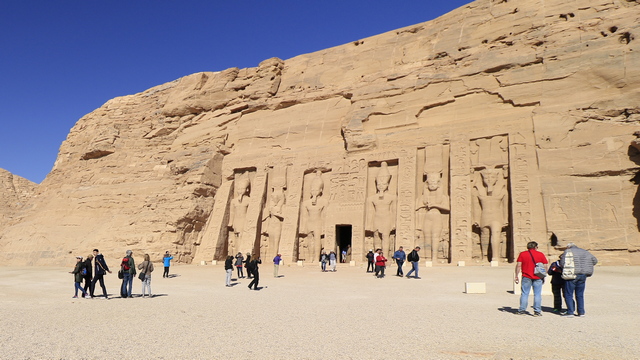
The front of the second temple.
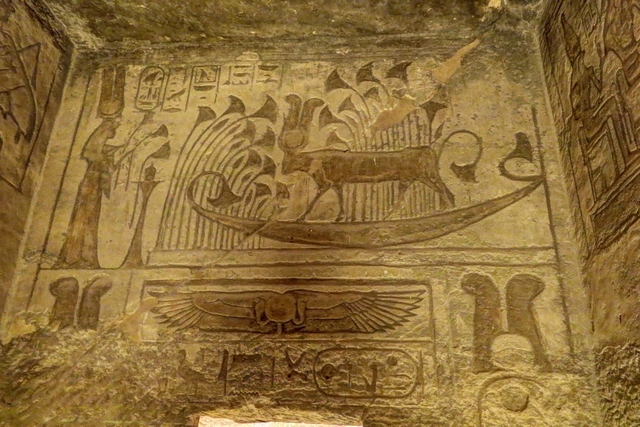
More amazing carvings, this time inside the second temple.
Driving back to Aswan we stopped on the High Dam. On one side of the road is the Nile River and on the other side is Lake Nasser, one of the worldís largest artificial lakes.
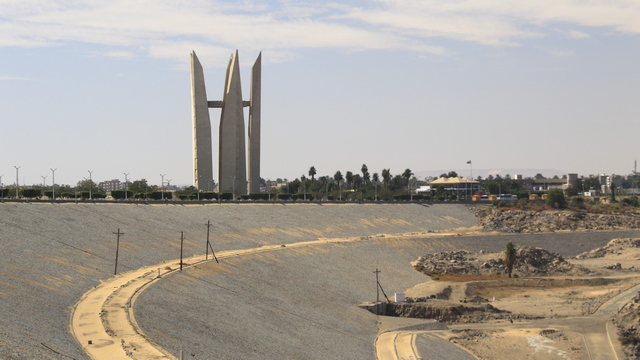
On the dam there is a monument honouring Soviet-Egyptian friendship and co-operation.
When we arrived back in Aswan we checked into our floating hotel, the Sonesta Star Goddess. This is our home base for the next four days and our transportation to Luxor.
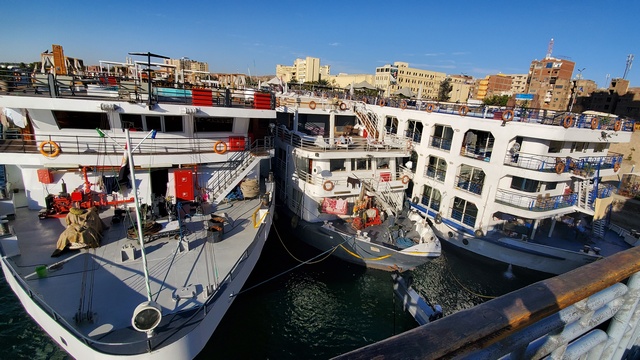
None of these boats are the one we are on, but itís interesting to see how the boats raft together. You just walk through the lobby of whatever boats are between you and the shore.
This evening we returned to Philea Temple Complex for a sound and light show. The show told about some of the myths that surround then temple and the about the more recent history of the temple complex being flooded when the Aswan dam was built and the subsequent moving of the complex. The show was really good.


A couple of shots with the lights on the buildings.
A quick history on Abu Simbel. The Great Temple of Ramses II and the Temple of Hathor combine to make up the Temples Abu Simbel. The temples were carved out of the mountain on the west bank of the Nile between 1274 and 1244 BC under the direction of Ramses II. The main temple is dedicated to the deified Ramses II himself as to Ra-Horakhty, Amun and Ptah (gods). The lesser temple is in honour of Ramses IIís favourite wife (Nefertari). Over the centuries both the Nile and the desert sands shifted and the temple was lost to the world until 1813 when it was rediscovered by chance by a Swiss explorer. In the 1960ís the ruler of Egypt decided that it was necessary to build a dam on the Nile River. The resulting lake would flood this temple and it would be lost possibly forever. Unesco stepped in and sponsored a team of archeologists to move the temple. A four year project saw the temple cut into pieces of no more than 30 tons/piece, moved to a storage location, then returned to itís new home on high ground above itís original location. The original temple is amazing, the fact that it was moved is amazing and the fact that you canít tell it was moved is even more amazing.

The front of the main temple


The inside of the main temple was filled with statues and amazing carvings.
The front of the second temple.

More amazing carvings, this time inside the second temple.
Driving back to Aswan we stopped on the High Dam. On one side of the road is the Nile River and on the other side is Lake Nasser, one of the worldís largest artificial lakes.
On the dam there is a monument honouring Soviet-Egyptian friendship and co-operation.
When we arrived back in Aswan we checked into our floating hotel, the Sonesta Star Goddess. This is our home base for the next four days and our transportation to Luxor.

None of these boats are the one we are on, but itís interesting to see how the boats raft together. You just walk through the lobby of whatever boats are between you and the shore.
This evening we returned to Philea Temple Complex for a sound and light show. The show told about some of the myths that surround then temple and the about the more recent history of the temple complex being flooded when the Aswan dam was built and the subsequent moving of the complex. The show was really good.

A couple of shots with the lights on the buildings.
2020/01/30: Blog will be late
Category: General
Posted by: The Agnew Family
We leave on our 3 day Nile cruise on January 31st so I won't be posting until we reach our hotel in Luxor.
2020/01/30: Camels, Plants and Nubians
Category: General
Posted by: The Agnew Family
Guess what time we had to be ready to leave the hotel today. The entire
group was happy when we heard departure was at 8 am --- not a leisurely
morning but it was daylight when we left.
Since the hotel is on an island, we all climb into a boat for a short ride to the west bank of the Nile River. Leaving the boat we boarded our next transportation ---- camels!!!! I was on a camel in 1995 but have forgotten everything about the ride other than I did it.

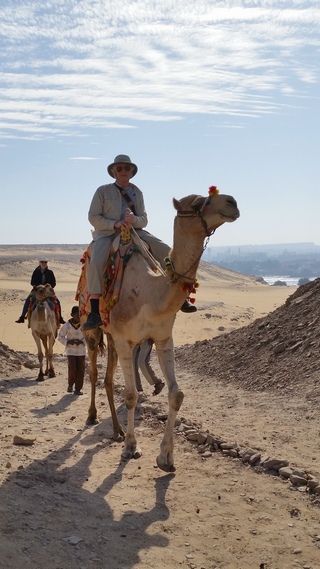
Don't Ed and I look like professional camel riders. It was a lot of fun.
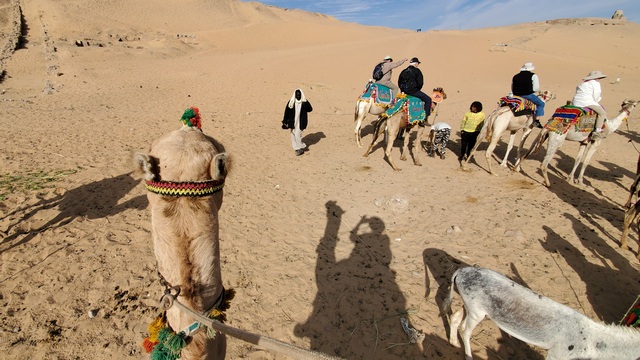
Some of our fellow camel riders. The shadow is Ed and his camel, Mona Lisa.
We had been riding for close to 45 minutes when we arrive at the ruins of the Monastery of St. Simeon. The original building was built in the 7th century then rebuilt in the 10th century. The monastery could house a thousand monks. It also acted as a hotel for Muslims on their way to Mecca.

The monastery.
After leaving the monastery we climbed aboard our camels and headed for the river where a boat was waiting to takes us to the Aswan Botanical Gardens on Kitchenerís Island. Kitchenerís Island was given to Lord Horatio Kitchener in the 1890ís when he was commander of the Egyptian army. Kitchener loved plants so imported them from all over the world and created the Aswan Botanical Gardens. After spending time in the dessert it was wonderful to walk through a tropical paradise.
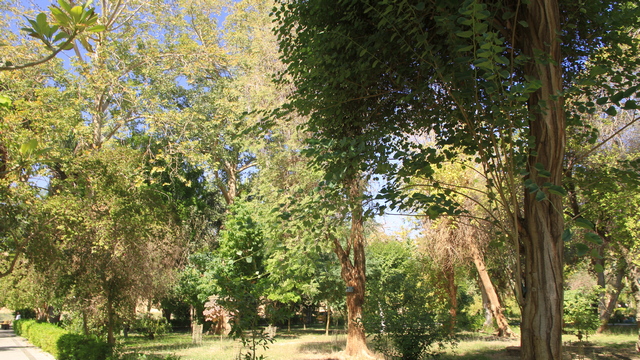
Walking through the lush greenery.
Later in the afternoon we got on another boat end enjoyed a leisurely drive down the river to a Nubian Village. Nubia is a nation that originated from southern Egypt and northern Sudan. Our guide said that approximately 40 percent of the population of Aswan is of Nubian decent. A large percentage of the Nubians were relocated when the High Dam was built, so there are few original Nubian homes left. The Nubian village that we visited today was one of the few villages that was spared.

The Nubian Village was an experience. The narrow one lane roads squeezed between shops is filled with people, camels, motorbikes and trucks. Everything works fine till one mode of transportation meets another mode of transportation going the other way, then chaos breaks out. We think everyone eventually got to where they going --- well at least we did.

A spice shop.
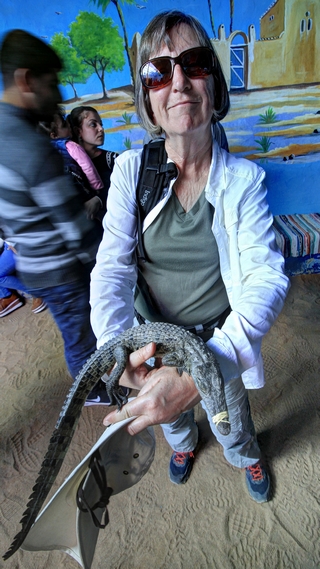

We visited a Nubian home, enjoyed some tea and Nubian food, held a crocodile, visited a spice shop, a weaving shop and school. The second photo is another felucca on the Nile photo.
Since the hotel is on an island, we all climb into a boat for a short ride to the west bank of the Nile River. Leaving the boat we boarded our next transportation ---- camels!!!! I was on a camel in 1995 but have forgotten everything about the ride other than I did it.

Don't Ed and I look like professional camel riders. It was a lot of fun.

Some of our fellow camel riders. The shadow is Ed and his camel, Mona Lisa.
We had been riding for close to 45 minutes when we arrive at the ruins of the Monastery of St. Simeon. The original building was built in the 7th century then rebuilt in the 10th century. The monastery could house a thousand monks. It also acted as a hotel for Muslims on their way to Mecca.

The monastery.
After leaving the monastery we climbed aboard our camels and headed for the river where a boat was waiting to takes us to the Aswan Botanical Gardens on Kitchenerís Island. Kitchenerís Island was given to Lord Horatio Kitchener in the 1890ís when he was commander of the Egyptian army. Kitchener loved plants so imported them from all over the world and created the Aswan Botanical Gardens. After spending time in the dessert it was wonderful to walk through a tropical paradise.
Walking through the lush greenery.
Later in the afternoon we got on another boat end enjoyed a leisurely drive down the river to a Nubian Village. Nubia is a nation that originated from southern Egypt and northern Sudan. Our guide said that approximately 40 percent of the population of Aswan is of Nubian decent. A large percentage of the Nubians were relocated when the High Dam was built, so there are few original Nubian homes left. The Nubian village that we visited today was one of the few villages that was spared.
The Nubian Village was an experience. The narrow one lane roads squeezed between shops is filled with people, camels, motorbikes and trucks. Everything works fine till one mode of transportation meets another mode of transportation going the other way, then chaos breaks out. We think everyone eventually got to where they going --- well at least we did.

A spice shop.


We visited a Nubian home, enjoyed some tea and Nubian food, held a crocodile, visited a spice shop, a weaving shop and school. The second photo is another felucca on the Nile photo.
2020/01/29: Temple, Obelisk and The Nile
Category: General
Posted by: The Agnew Family
We thought yesterday was an early morning. This morning proved that
there are earlier days on this trip. We were up at 4:00am, ate breakfast
at 4:30am, on the bus at 5:15 am so we could catch a 7:30 flight. We
arrived at the gate about 5 minutes before we were able to board the
plane, so I think we left at the correct time.
On the way to the hotel we stopped at Philae temple. The temple was perched on Philae Island and attracted pilgrims for thousands of years. After the completion of the Aswan High Dam, the temple would have entirely disappeared had Unesco not intervened. Between 1972 and 1980, the temple complex was disassembled stone by stone . It was reconstructed 20 meters higher on Agilika Island. The earliest surviving remains are from 380 BC. Early Coptic Christians transformed the main hall in the temple to a chapel, defaced some of the reliefs and carved crosses on some the walls. Our guide, who has a PhD in Hieroglyphics gave us an amazing tour. He explained many of the hieroglyph reliefs and taught us to recognize certain characters so we could read the tiniest bit of the hieroglyphics.
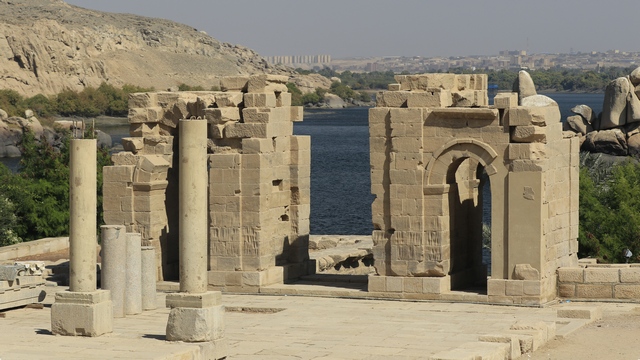
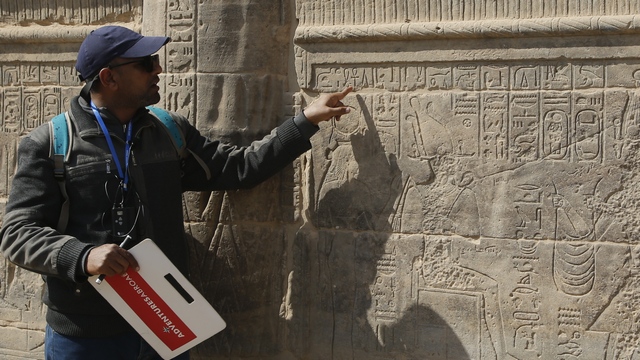
Our guide teaching us how to interpret hieroglyphics
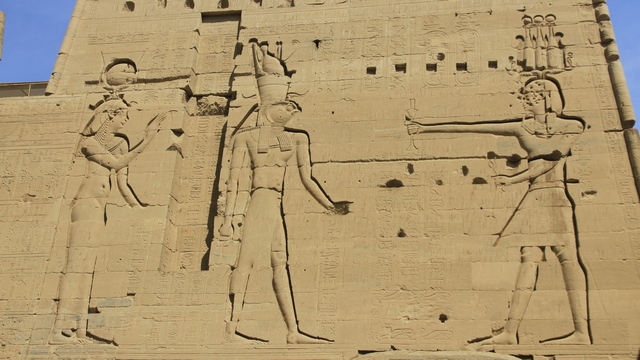
One of the walls of the temple
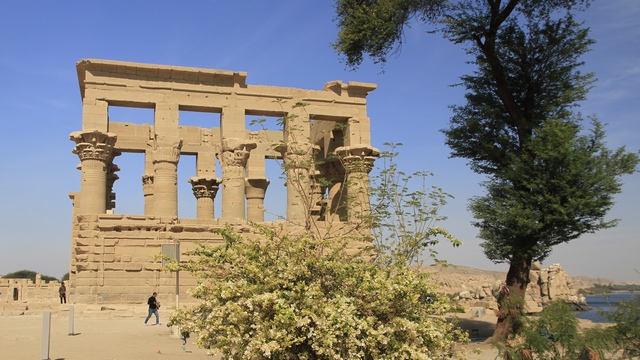
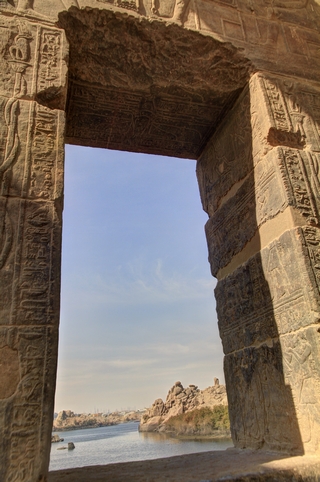
We also stopped to see the unfinished obelisk in the red granite quarry in downtown Aswan. Three sides of the nearly 42 meter shaft were completed when a crack occurred near the top of the obelisk. It was abandoned and left in place.

the obelisk
I love the location of our hotel. It is on Elephantine Island in the middle of the Nile River. Every room has an amazing view. We look over the river at the city as Aswan.
The Nile River is full of boats. One type of boat is the felucca. The felucca has a single sail and has been sailing on the Nile River since they began sailing boats on the Nile River.
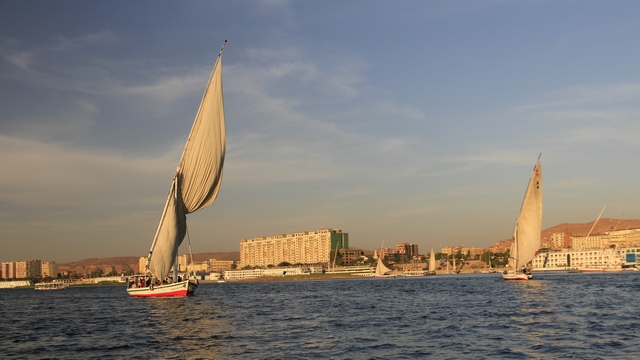
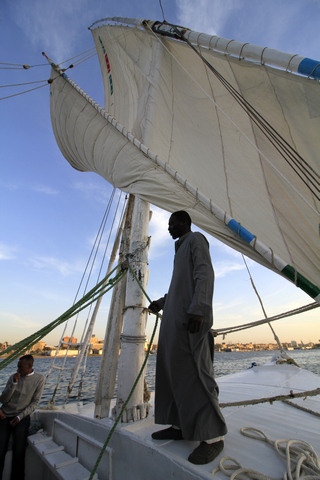
the captain
About an hour before sunset we boarded the felucca and began to sail around Elephantine Island. As the sun was setting we transferred to a motor powered boat.

We finished watching an amazing sunset as we drove to a houseboat where we enjoyed a fabulous dinner prepared by a Nubian family. Tomorrow we are going to visit a Nubian village so Iíll be able to tell you more about them.
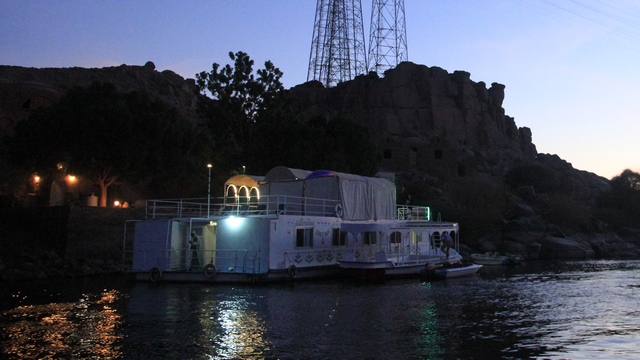
On the way to the hotel we stopped at Philae temple. The temple was perched on Philae Island and attracted pilgrims for thousands of years. After the completion of the Aswan High Dam, the temple would have entirely disappeared had Unesco not intervened. Between 1972 and 1980, the temple complex was disassembled stone by stone . It was reconstructed 20 meters higher on Agilika Island. The earliest surviving remains are from 380 BC. Early Coptic Christians transformed the main hall in the temple to a chapel, defaced some of the reliefs and carved crosses on some the walls. Our guide, who has a PhD in Hieroglyphics gave us an amazing tour. He explained many of the hieroglyph reliefs and taught us to recognize certain characters so we could read the tiniest bit of the hieroglyphics.
Our guide teaching us how to interpret hieroglyphics
One of the walls of the temple

We also stopped to see the unfinished obelisk in the red granite quarry in downtown Aswan. Three sides of the nearly 42 meter shaft were completed when a crack occurred near the top of the obelisk. It was abandoned and left in place.
the obelisk
I love the location of our hotel. It is on Elephantine Island in the middle of the Nile River. Every room has an amazing view. We look over the river at the city as Aswan.
The Nile River is full of boats. One type of boat is the felucca. The felucca has a single sail and has been sailing on the Nile River since they began sailing boats on the Nile River.
the captain
About an hour before sunset we boarded the felucca and began to sail around Elephantine Island. As the sun was setting we transferred to a motor powered boat.
We finished watching an amazing sunset as we drove to a houseboat where we enjoyed a fabulous dinner prepared by a Nubian family. Tomorrow we are going to visit a Nubian village so Iíll be able to tell you more about them.
2020/01/28: Alexandria
Category: General
Posted by: The Agnew Family
Alexandria is on the Mediterranean Sea and is approximately 230 km from
Giza, so we were up at 5am, eating breakfast at 5:30am and on the road
just after 6:30am. We were told that traffic might be bad but once we
left the city streets and were on the highway we had clear sailing.
Alexandria was founded in 331 BC by 25 year old Alexander the Great. Alexandria's history bridges the time between the pharaohs and the coming of Islam. The city gave rise to the last great Pharaonic dynasty, the Ptolemies. Cleopatra was the last member of the Ptolemy family to rule Egypt.
First stop in Alexandria was the Roman Catacombs. These catacombs were discovered accidentally in 1900 when a donkey disappeared through the ground. These catacombs make up the largest known Roman burial site in Egypt. The narrow spiral staircase was almost enough to send claustrophobic me back to the surface but once we were down in the open chambers I was OK.
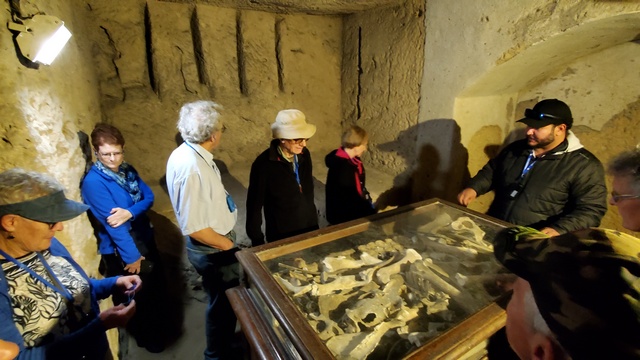
One of the rooms in the catacombs was found to contain horse bones. The archaeologists believe the horses were prized racehorse.

Another room in the catacombs had beautiful carvings. Outside of the room were 2 statues, one of a man and the other of a woman. The archaeologists believe that the man and woman were important just not important enough to have their own tomb.
Next stop was the Pompey's Pillar and the Temple of Serapeum. A massive 30 meter column towers over the debris of the ancient settlement of Rhakotis, the original town from which Alexandria grew. Pompey's Pillar is made from red Aswan granite.
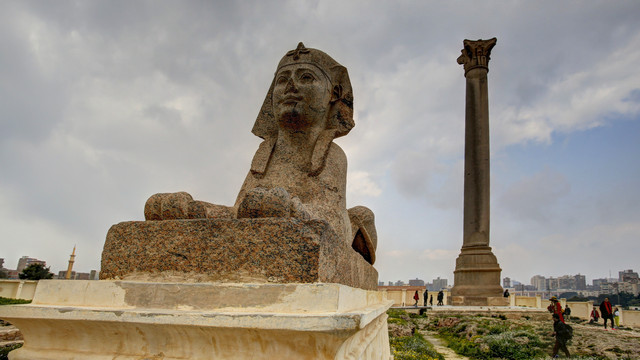
Pompey's Pillar is made from red Aswan granite. The photo shows one Spinx but there are actually 2 on the site. The photographic angle is showing the Spinx to be massive, it's actually a lot smaller than the pillar.
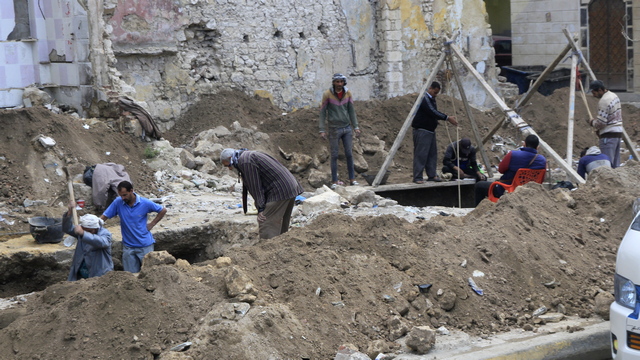
Across the street from Pompey's Pillar we saw men using a pickax and removing dirt from a hole with a bucket. The man sitting in the red chair was watching everything that came out of the bucket ---- were guessing he's an archaeologist overseeing the site.
The Roman Amphitheater dates back to the second century AD. It was discovered by chance in 1960 when some remains from Napoleon's time were being removed. The site includes an ancient Roman theater, baths and a villa with mosaics. Our guide believes that there are more remains under parts of the city.
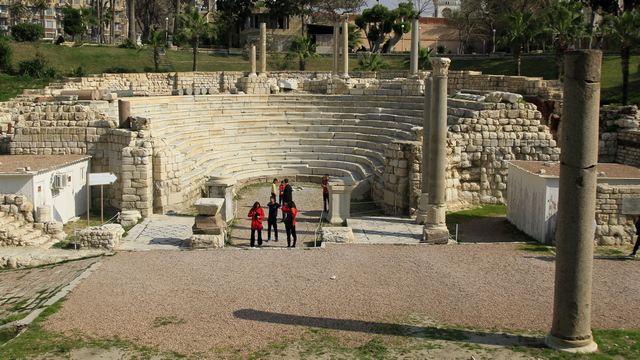
The theater.
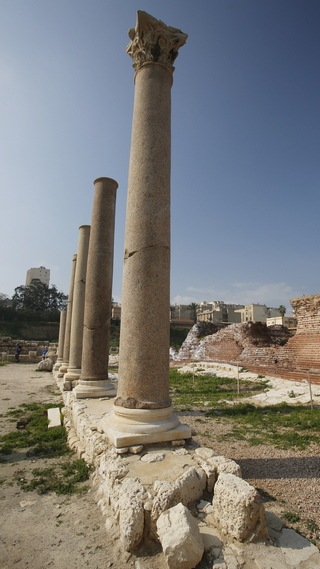
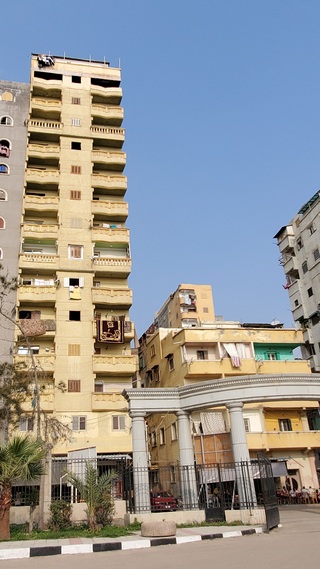
The photo on the left is of a row of pillars at the villa area of the amphitheater site. The photo on the left is a common scene so far in Eqypt. Laundry is hung from the balcony to dry. Not sure if it'll come in cleaner than before it was washed.
It is thought that the Ancient Library of Alexandria was destroyed in a fire in 48 BC. In 2002 the Bibliotheca Alexandrina opened. "The building takes the form of a gigantic angled discus embedded in the ground evoking a second sun rising out of the Mediterranean. The granite exterior walls are carved with letters, pictograms, hieroglyphs and symbols from more than 120 different human scripts."(borrow from Lonely Planet). The building was amazing and we wish we could have had more time to explore it but we needed to start the drive back to Giza.
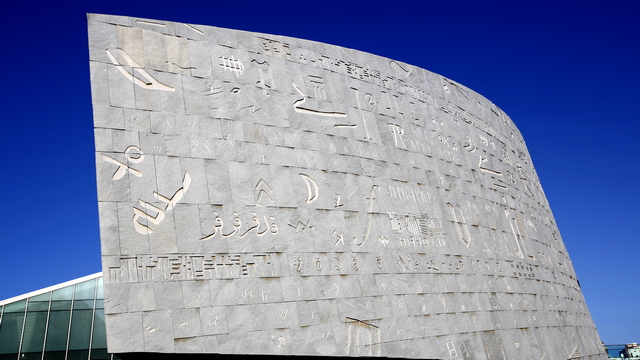
The outisde wall of the library.
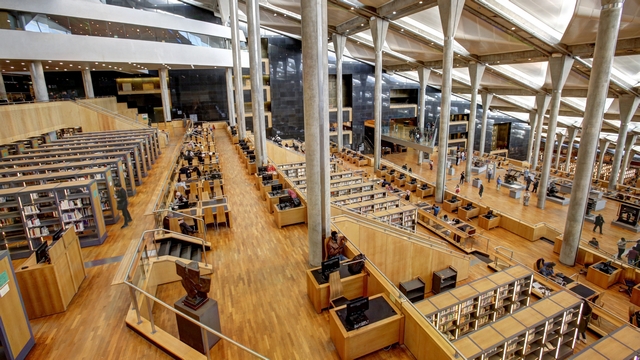
A view of the inside of the library.

Alexandria is known for car parts as the city is home to a big part. What's really interesting is the "half car" parts. To avoid paying import taxes on a car it is cut in half. When you want a new car you just have to buy the front half, the back half and find someone to put it back together. Our guide told a story of how his brother did this then sold the car. The buyer didn't know and couldn't tell that the car had come in 2 pieces.
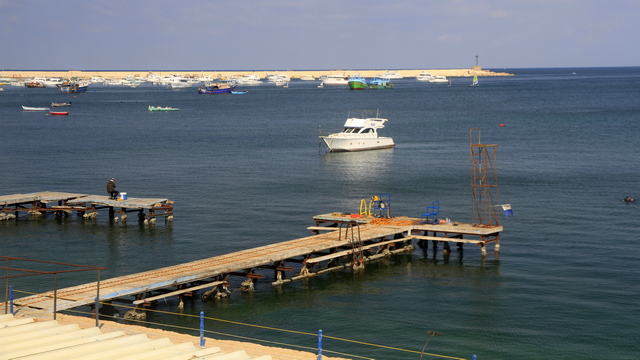
We enjoyed a wonderful seafood lunch overlooking the Mediterranean.
Alexandria was founded in 331 BC by 25 year old Alexander the Great. Alexandria's history bridges the time between the pharaohs and the coming of Islam. The city gave rise to the last great Pharaonic dynasty, the Ptolemies. Cleopatra was the last member of the Ptolemy family to rule Egypt.
First stop in Alexandria was the Roman Catacombs. These catacombs were discovered accidentally in 1900 when a donkey disappeared through the ground. These catacombs make up the largest known Roman burial site in Egypt. The narrow spiral staircase was almost enough to send claustrophobic me back to the surface but once we were down in the open chambers I was OK.

One of the rooms in the catacombs was found to contain horse bones. The archaeologists believe the horses were prized racehorse.

Another room in the catacombs had beautiful carvings. Outside of the room were 2 statues, one of a man and the other of a woman. The archaeologists believe that the man and woman were important just not important enough to have their own tomb.
Next stop was the Pompey's Pillar and the Temple of Serapeum. A massive 30 meter column towers over the debris of the ancient settlement of Rhakotis, the original town from which Alexandria grew. Pompey's Pillar is made from red Aswan granite.

Pompey's Pillar is made from red Aswan granite. The photo shows one Spinx but there are actually 2 on the site. The photographic angle is showing the Spinx to be massive, it's actually a lot smaller than the pillar.
Across the street from Pompey's Pillar we saw men using a pickax and removing dirt from a hole with a bucket. The man sitting in the red chair was watching everything that came out of the bucket ---- were guessing he's an archaeologist overseeing the site.
The Roman Amphitheater dates back to the second century AD. It was discovered by chance in 1960 when some remains from Napoleon's time were being removed. The site includes an ancient Roman theater, baths and a villa with mosaics. Our guide believes that there are more remains under parts of the city.
The theater.

The photo on the left is of a row of pillars at the villa area of the amphitheater site. The photo on the left is a common scene so far in Eqypt. Laundry is hung from the balcony to dry. Not sure if it'll come in cleaner than before it was washed.
It is thought that the Ancient Library of Alexandria was destroyed in a fire in 48 BC. In 2002 the Bibliotheca Alexandrina opened. "The building takes the form of a gigantic angled discus embedded in the ground evoking a second sun rising out of the Mediterranean. The granite exterior walls are carved with letters, pictograms, hieroglyphs and symbols from more than 120 different human scripts."(borrow from Lonely Planet). The building was amazing and we wish we could have had more time to explore it but we needed to start the drive back to Giza.
The outisde wall of the library.

A view of the inside of the library.
Alexandria is known for car parts as the city is home to a big part. What's really interesting is the "half car" parts. To avoid paying import taxes on a car it is cut in half. When you want a new car you just have to buy the front half, the back half and find someone to put it back together. Our guide told a story of how his brother did this then sold the car. The buyer didn't know and couldn't tell that the car had come in 2 pieces.
We enjoyed a wonderful seafood lunch overlooking the Mediterranean.
2020/01/27: Pyramid Day
Category: General
Posted by: The Agnew Family
This morning was an early morning.... we were up, ate breakfast and were in the bus on our way at 7:30 am.
First stop of the day was Memphis. Around 3100 BC, the legendary pharaoh Narmer (Menes) unified the two lands of Upper and Lower Egypt and founded Memphis, symbolically on the spot where the Nile Delta met the valley. For most of the Pharaonic period, Memphis was the capital of Egypt. (Borrowed from Lonely Planet Egypt).
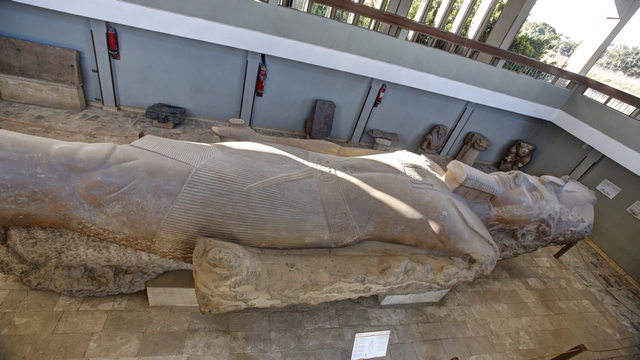
All that is left of the ancient city of Memphis is an open air museum built around a fallen statue of Ramses II.
A more interesting spot is Saqqara, the huge cemetery of ancient Memphis. Saqqara was an active burial ground for 3500 years and is Egypt's largest archaeological site.
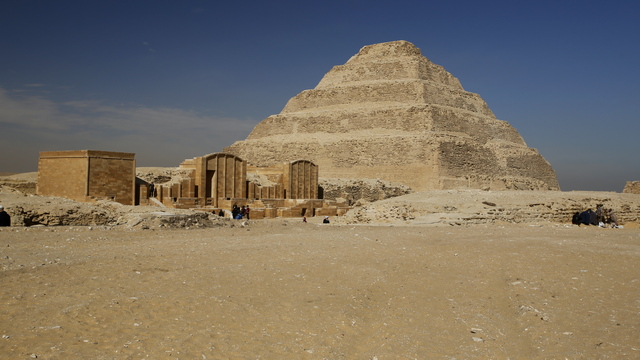
The highlight is the Step Pyramid, the prototype for the pyramid.
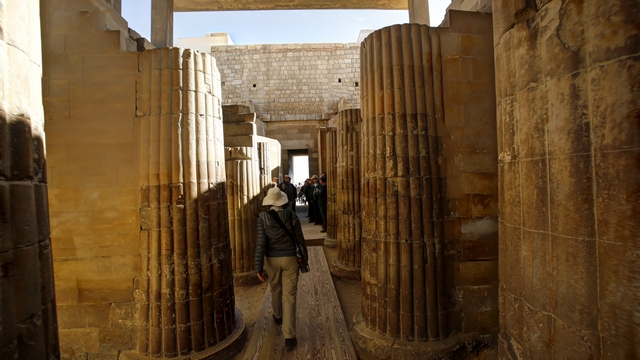
A closer look at the building to the left of the step pyramid.
There are a number of pyramids and many tombs at Saqqara.
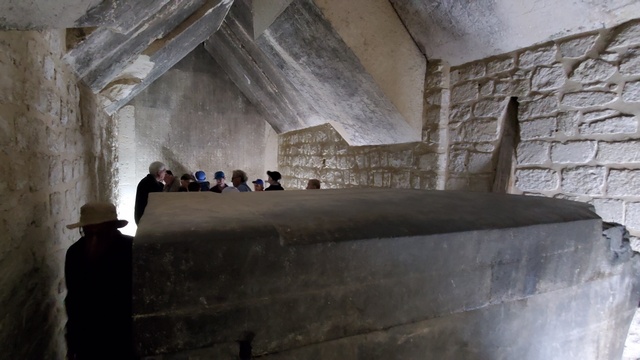
Most of the group went into a pyramid that was mostly rubble on top but had a good interior. Some of us who are claustrophobic (me) opted to stay outside and hold the cameras.
Our guide has never been to Dahshur, a site with 2 intact and interesting pyramids, so he asked if we would mind going to see it. No one objected.

First we enjoyed a drive through a farm area with many date trees and fields growing a variety of things.
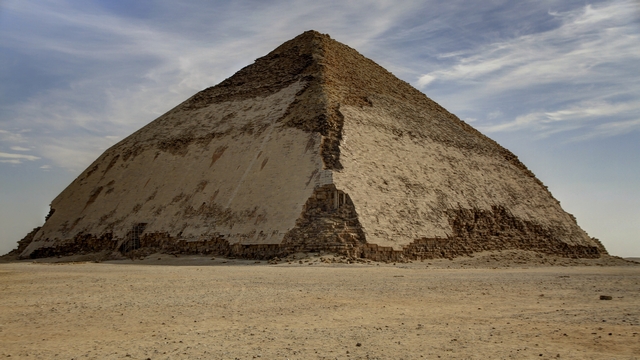
The first pyramid (the Bent Pyramid) at Dahshur started being built at the wrong angle ---- I think 54 degrees ---- half way through the angle was readjusted. When this pyramid was completed a 2nd one (the Red Pyramid) was built using the new angle of 51.5 degrees and it was perfect.
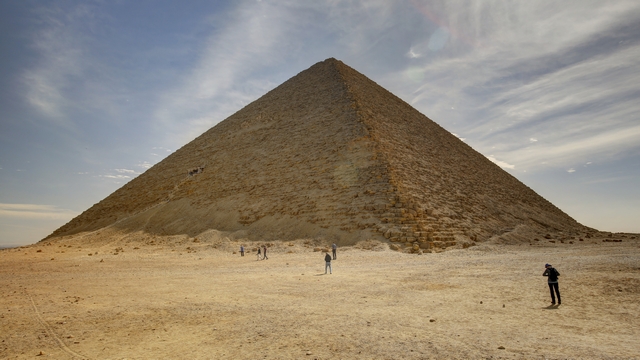
The king was buried in the Red Pyramid, the oldest true pyramid.
The next stop were the pyramids at Giza, the ones near our hotel and the ones everyone visits. Four famous sites can be found here The Great Pyramid of Khufu (the father), the Pyramid of Khafre (the son), the Pyramid of Menkaure (the grandson) and the Sphinx. There are a number of other pyramids for lesser people on the grounds.

Starting from the left the Great Pyramid of Khufu, the Pyramid of Khafre and the Pyramid of Menkaur.

The Pyramid of Khafre
And for a bit of fun

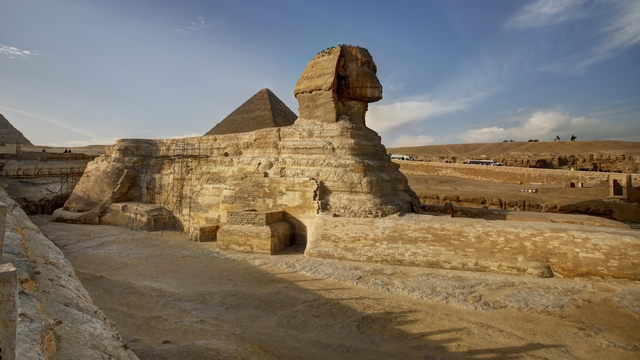
The Sphinx is a statue carved from the bedrock at the bottom of the causeway. It was restored not using original methods.

The token camel photo.
First stop of the day was Memphis. Around 3100 BC, the legendary pharaoh Narmer (Menes) unified the two lands of Upper and Lower Egypt and founded Memphis, symbolically on the spot where the Nile Delta met the valley. For most of the Pharaonic period, Memphis was the capital of Egypt. (Borrowed from Lonely Planet Egypt).

All that is left of the ancient city of Memphis is an open air museum built around a fallen statue of Ramses II.
A more interesting spot is Saqqara, the huge cemetery of ancient Memphis. Saqqara was an active burial ground for 3500 years and is Egypt's largest archaeological site.
The highlight is the Step Pyramid, the prototype for the pyramid.

A closer look at the building to the left of the step pyramid.
There are a number of pyramids and many tombs at Saqqara.

Most of the group went into a pyramid that was mostly rubble on top but had a good interior. Some of us who are claustrophobic (me) opted to stay outside and hold the cameras.
Our guide has never been to Dahshur, a site with 2 intact and interesting pyramids, so he asked if we would mind going to see it. No one objected.
First we enjoyed a drive through a farm area with many date trees and fields growing a variety of things.

The first pyramid (the Bent Pyramid) at Dahshur started being built at the wrong angle ---- I think 54 degrees ---- half way through the angle was readjusted. When this pyramid was completed a 2nd one (the Red Pyramid) was built using the new angle of 51.5 degrees and it was perfect.

The king was buried in the Red Pyramid, the oldest true pyramid.
The next stop were the pyramids at Giza, the ones near our hotel and the ones everyone visits. Four famous sites can be found here The Great Pyramid of Khufu (the father), the Pyramid of Khafre (the son), the Pyramid of Menkaure (the grandson) and the Sphinx. There are a number of other pyramids for lesser people on the grounds.

Starting from the left the Great Pyramid of Khufu, the Pyramid of Khafre and the Pyramid of Menkaur.

The Pyramid of Khafre
And for a bit of fun

The Sphinx is a statue carved from the bedrock at the bottom of the causeway. It was restored not using original methods.
The token camel photo.
2020/01/26: we have arrived
Category: General
Posted by: The Agnew Family
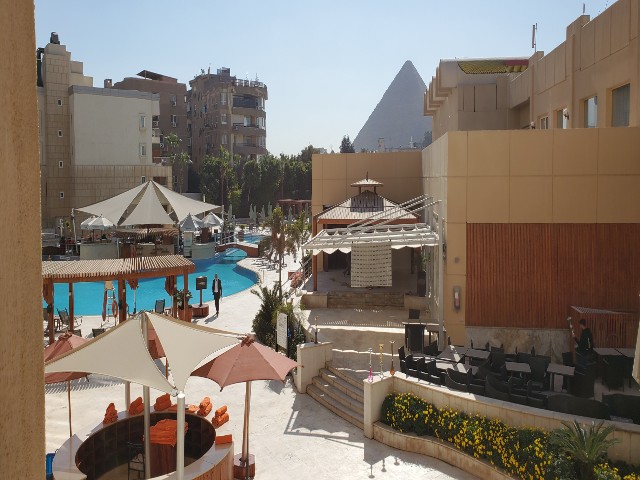
the view from our room.
We arrived a day before the start of tour. Given winter weather in Ontario can cause flight delays and we had to change planes in Frankfurt we decided that it was prudent to leave a day early --- it would guarantee no problems. And it worked.
In case you haven't figured it out from the photo from our room we are in Cairo Egypt. On this trip we are spending 2 weeks touring Egypt and 1 week touring Jordan.
As usual we didn't get a lot of sleep on the plane and we were able to do catch up last night ---- went to bed at 9 pm and woke up at 9:50 am. Ok, Ed got all that sleep I was awake for about 3 hours in the night but managed to get back to sleep so I got my fair share of sleep.
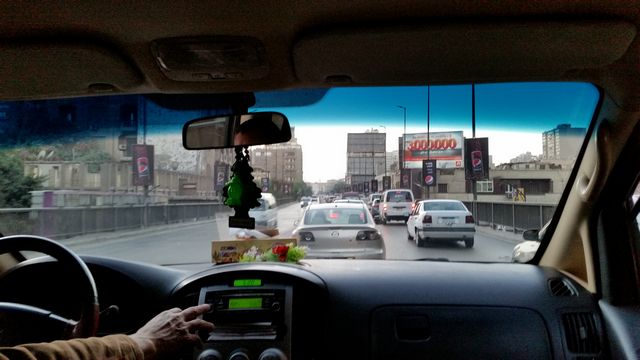
The drive from the airport to the hotel last evening was interesting. Being a Saturday we were told that the traffic would be lighter ..... I hate to see it when it is really busy as it was stop in go in places. The accident we eventually passed probably didn't help matters.
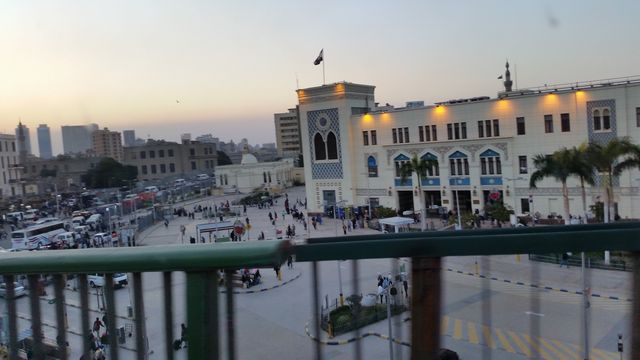
The train station.
We drove passed a number of mosques, some new looking buildings and some older building. A google search indicates that there are 20 million people living in Cairo and more than 95 million people living in Egypt with 95% of them living along the Nile river. I guess that explains why the traffic seemed heavy.
Security is very visible. All vehicles driving onto the hotel property are searched by a dog (today's dog was a golden retriever that happily accepted pets from Ed). Bags went through an x-ray machine and people go through a metal detector when entering the hotel.
Our hotel is within walking distance to pyramids, so we decided to walk over and have a look. We didn't go in as a visit to the pyramids is included in our tour tomorrow. There's a visible police presence in the area which increased dramatically as we walked up the road towards the pyramids.
A view of the pyramids from our hotel. The top of the third pyramid is just visible.
We saw truck loads of tomatoes, a motorbike pulling a trailer loaded high, a donkey pulling a cart and several trucks taking some cows out for a drive.
Near the pyramids you can get a tour in horse and buggy ride. I felt sorry for this horse as it had very little traction coming down the hill and slid on it's back legs a few times.
A closer view of the Great Pyramid of Khufu.
2020/01/24: and we're off.....
Category: General
Posted by: The Agnew Family
well soon. We're sitting at the gate reading and relaxing. No snow no stress.
2020/01/23: Leaving on a Jet Plane ..... tomorrow
Category: General
Posted by: The Agnew Family
I can't believe that tomorrow is January 24, 2020 and Ed and I will be leaving on our 3 week trip to Egypt and Jordan.
The last six months have been incredibly busy and somewhat stressful and part of me is wondering why we are going away but the other part of me knows that Ed and I both need a break. I'm hoping that I will be able to relax and enjoy this, what should be amazing, trip. The awe inspiring pyramids and all the history that goes with them, a 3 day cruise on the Nile, walking into the hidden city of Petra and floating in the dead sea.
We opted to join a tour for this trip --- between the volatility in the middle east, potential language barriers and wanting guides overflowing with historical information booking with a tour company seemed like the right thing to do. This particular tour has a maximum of 16 people, which we have found to be a good number in the past.
We leave Toronto tomorrow evening, fly to Frankfurt, transfer to another plane and continue on to Cairo landing on Saturday the 25th in the late afternoon. It's going to be a long day ---- hope I can sleep on the plane.
The last six months have been incredibly busy and somewhat stressful and part of me is wondering why we are going away but the other part of me knows that Ed and I both need a break. I'm hoping that I will be able to relax and enjoy this, what should be amazing, trip. The awe inspiring pyramids and all the history that goes with them, a 3 day cruise on the Nile, walking into the hidden city of Petra and floating in the dead sea.
We opted to join a tour for this trip --- between the volatility in the middle east, potential language barriers and wanting guides overflowing with historical information booking with a tour company seemed like the right thing to do. This particular tour has a maximum of 16 people, which we have found to be a good number in the past.
We leave Toronto tomorrow evening, fly to Frankfurt, transfer to another plane and continue on to Cairo landing on Saturday the 25th in the late afternoon. It's going to be a long day ---- hope I can sleep on the plane.